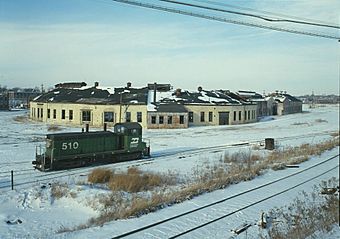Two Brothers Roundhouse facts for kids
Quick facts for kids |
|
|
Chicago, Burlington, & Quincy Roundhouse and Locomotive Shop
|
|

America's Historical Roundhouse served the Chicago, Burlington & Quincy Railroad from 1856 to 1974
|
|
| Location | Broadway and Spring Streets Aurora, Illinois |
|---|---|
| Built | 1856 |
| Architect | Levi Hull Waterhouse |
| NRHP reference No. | 78001154 |
| Added to NRHP | February 16, 1978 |
The Two Brothers Roundhouse is a special old building in Aurora, Illinois. It used to be called the Walter Payton Roundhouse and America's Historical Roundhouse. Today, it's a popular restaurant and entertainment spot.
This building was first built in 1856. It was a roundhouse for trains, a place where locomotives (train engines) were stored and repaired. It served the Chicago and Aurora Railroad and later the Chicago, Burlington and Quincy Railroad until 1974.
After being empty for many years, a famous football player named Walter Payton helped buy it in 1995. They turned it into a fun place with restaurants and shops. Now, Two Brothers Brewing runs the main restaurant there. This roundhouse is the oldest building of its kind made from limestone in the whole United States. It's even listed on the National Register of Historic Places because it's so important!
Contents
The Roundhouse's Long History
Building a Home for Trains
The roundhouse was built in 1856 for the Chicago & Aurora Railroad (C&A). The C&A needed a place to fix their trains. They also wanted to build new train parts as their railway grew. This helped them expand their train lines to the west.
A man named Levi Hull Waterhouse designed the roundhouse. He designed many important buildings in the Aurora area. The walls of the building were made from limestone. This stone came from a nearby town called Batavia, Illinois.
When it was first built, the roundhouse had 22 spots for trains. Three years later, eight more spots were added. Later on, ten more spots were built. There was also a small shop inside to work on the train engines.
Changes and New Trains
In 1868, the C&A railroad joined with the Chicago, Burlington and Quincy Railroad. By 1870, this new railroad became the busiest in Illinois. In the 1930s, the roundhouse started focusing on new, faster diesel trains called Zephyr engines.
The shops also built many passenger cars. These included fancy Pullman cars and the very first dome car. Dome cars have a special glass roof for passengers to see the views.
Closing and Reopening
As more people started using cars in the mid-1900s, fewer people rode trains. Because of this, the roundhouse and its shops closed in 1974. Most of the other train shops nearby were torn down soon after.
The roundhouse building was empty for 21 years. It was added to the National Register of Historic Places in 1978. This means it's a very important historical site. In 1988, it was also recognized for its "innovative railroad yard machine shop."
In 1995, the city of Aurora allowed a group of investors to buy the building. This group was led by Walter Payton, a famous football player from the Chicago Bears. The building reopened in 1996. It became a fun place with a restaurant, a museum, and an outdoor area. The museum even had Walter Payton's championship ring from Super Bowl XX!
The complex won a special award in 1999. It was called a National Preservation Award. This award recognized how well the old building was saved and reused.
On May 2, 2011, Two Brothers Brewing Company announced they had bought the roundhouse. They opened their restaurant there on June 18, 2011. They serve their own special beers and other unique ones.
Building Design and Features
The roundhouse part of the building is about 264 feet long. It has an outside made of local limestone. Inside, it has an iron loggia, which is like a covered walkway. The roundhouse actually has 40 sides, making it a unique shape!
A strong steel frame holds up the roof. The roof is made of wood covered with tar paper. The locomotive shop is attached to the north side of the roundhouse. It is about 50 feet wide and 180 feet long. It has two stories, each about 16 feet tall.
- Historic American Engineering Record (HAER) No. IL-8, "Chicago, Burlington & Quincy Railroad, Roundhouse & Shops"



